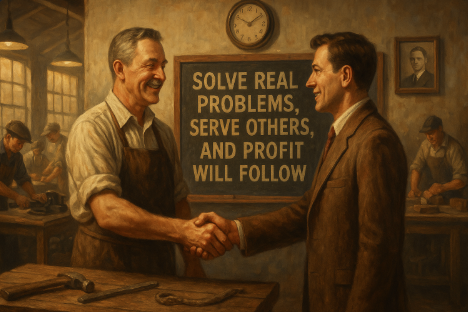
Last week, I highlighted a curious reality: despite incredible advances in tech and productivity, most people are still working as much as ever just to cover the basics. Real wages have gone flat, while the costs of essentials like housing, healthcare, and energy keep climbing.
Once you see it, it’s tough to ignore. It cries out for an explanation.
It’s similar, and somewhat related, to the question of why some countries are rich while others remain poor – a conundrum Adam Smith tried to tackle all the way back in 1776 in The Wealth of Nations.
Smith’s view was that prosperity derived from productive efficiency and free markets. In the pre-industrial world of his time, this meant that when people specialized in tasks they were best at – what he called the division of labor – productivity would rise. And with the enforcement of contracts and property rights, free, open, and competitive markets would help ensure that these productivity gains translated into broader wealth for society as a whole.
It was an astute thesis, and considering it was written nearly 250 years ago, it has largely stood the test of time, still serving as a foundation for much of modern economics.
More recently, in 2012, economists Daron Acemoglu and James Robinson expanded on these ideas, presenting a lot of empirical evidence to explain the differences in wealth across countries.
In Why Nations Fail: The Origins of Power, Prosperity, and Poverty, Acemoglu and Robinson argue that while productivity gains are fundamental to wealth, it’s actually the inclusiveness and effectiveness of a country’s institutions that determine not only how much wealth is created, but also how it’s distributed among those who helped create it.
It’s fairly obvious, really. Without sensible and fair laws – and institutions that uphold them – a country tends to lean toward autocracy, dictatorship, and other extractive power structures.
And by “institutions,” they mean not just government, but everything from the media and banking to healthcare and regulatory agencies. Each of these plays a role in shaping the rules, incentives, and opportunities that determine whether a society’s wealth flows fairly to those who help create it, or whether it’s captured by a privileged few.
When these institutions work well, they support fair competition and innovation; when they don’t, they fuel inequality and stagnation.
Here in Australia, and across much of the West, we have relatively effective and inclusive institutions. According to Acemoglu and Robinson, this is a huge part of why we’re so wealthy.
But our institutions aren’t flawless. And they’re increasingly falling short of the ideal. The sharp decline in public trust in media, politics, and banking is testament to that.
When people think the system’s rigged, they start looking for alternatives – even radical ones. The most obvious manifestation of this is the return of a certain US Commander in Chief.
The point is that productivity and economic growth alone aren’t enough to ensure widespread prosperity. If the institutions underpinning that growth aren’t effective, then the benefits won’t accrue fairly. And when wealth pools at the top, due more to privilege than value creation, it breeds unnecessary hardship for everyone else.
There’s no grand conspiracy at play, just poor incentives.
And nowhere is this clearer than within the financial system. Which is troubling when you consider just how vital a role it plays in the health of the economy and society.
Money functions as a core institution in society, coordinating trade and (in theory) serving as a store of value. It’s the very lifeblood of the whole damn system.
You can get really deep on this, but it really boils down to the fact that both the amount and cost of money are pretty critical. So it pays to understand how these factors are influenced, and by whom.
Central banks get a lot of attention for “printing money”, and that’s definitely part of the story. But in reality, most money is created by commercial banks.
Whenever a bank issues a loan, new money is effectively created. It’s recorded as an entry on the bank’s database and matched on its balance sheet against the borrower’s promise to repay. Banks are allowed, and often encouraged, to do this as long as they hold a minimum fraction of the loan’s value in cash or central bank reserves.
It always sounds a little mad, but the fact is fractional reserve banking has been around a long time, and many economists see it as essential for fueling economic growth. Most of the time it works just fine.
The point, though, is that this is how most new money enters the system.
Now, mathematically, if money grows faster than the ‘stuff’ it buys (i.e., goods and services), you get inflation. But ideally, a lot of credit goes toward productive uses, allowing value creation to outpace any inflation. And as debts are repaid, the added money is effectively removed from the system.
The problem is, credit doesn’t always fund productive uses. And when enough debt-fuelled malinvestment builds up, defaults start cropping up, threatening the very solvency of the entire banking system.
Left unchecked, this can lead to a nasty and protracted deflationary bust.
The so-called Cantillon effect also helps exacerbate the wealth divide. Those with assets tend to enjoy far cheaper and easier access to credit, which allows them to acquire even more assets – importantly, before the dilutionary impact of the new money is noticeable.
In politics, proximity to the spigot is a big advantage too. And beyond that, government is a famously poor allocator of capital and is responsible for a great deal of unproductive investment (something you can probably point to without accusations of ideological or partisan bias).
That’s bad enough, but it’s far worse when that spending is financed by debt. And then it gets really ugly when the debt can’t (or won’t) be provided by the private sector, prompting central banks to step in as the buyer of last resort.
Oh, and if that debt isn’t priced at an appropriate market rate, things really start to get silly.
Again, there’s no evil agenda at work. In fact, a lot of the policy response is often well-intentioned. But factors like moral hazard, political expediency, cronyism, and economic naivety have helped undermine the effectiveness of our most important institutions.
This is an overly simplistic and extremely surface-level view of things, but my point is that all of this has resulted in the amount of money increasing faster than the amount of stuff our current productive capacity allows us to generate. And an insidious feedback loop has seen the vast majority of value accrue to those who were already rather wealthy to begin with.
That’s why, in my opinion, things are getting harder – at least for those that don’t have assets and/or above average earning power.
Our institutions as a whole, while still fantastic compared to what you might find in less prosperous parts of the world, just seem to have failed us to some degree. And, while it may just be the seductive pull of doomerism, things don’t seem to be getting any better.
The point of all this is not to try and offer some grand prescription to remedy the flaws of our social and economic structures (although I’m always keen over a few beers).
Aside from advocating for change and urging our leaders to push for genuine and effective reform, there’s not a lot we as individuals can do to steer things in a better direction. We should still push for that, of course. But it’s also probably wise to position yourself in a way that recognises the reality of the situation.
If you’re reading this, you probably have some investable capital and aren’t burdened with excessive debt. Consider yourself lucky.
And if you want to make the most of your good fortune (and, yes, your hard work and sacrifice too), it pays to think about where to park your wealth – somewhere that strikes a balance between maximizing returns and ensuring resilience.
Pick your poison: property, equities, whatever. The key thing in my mind is finding assets with a real foundation of value. Good land and good businesses will always be worth holding, as long as the price isn’t crazy high and you don’t over-leverage.
In fact, too much debt is one of the surest ways to blow yourself up.
It’s funny, whatever economic picture you want to paint, that’s the conclusion I always seem to land on. Which, I guess, is kind of nice if you like to avoid being too reliant on the macro landscape.
But I will add this given the current context; unless you are some gun macro trader, I’d avoid bonds like the plague. In the latter stages of a debt supercycle, you don’t want to be a creditor. Not least to those who will almost invariably repay you in diluted currency.
It’s also worth pointing out the potential for more volatility. If there’s one thing markets hate, it’s uncertainty. And given who’s seated in the White House, not to mention all the other things happening in the world, you can guarantee there’ll be plenty of that.
Even if you own the most high quality of assets, if you can’t keep your head when the bears are in charge, you can still easily be scared into taking unnecessary losses. The only real remedy here is to really make sure you’ve put the work in to build the necessary conviction to hold.
In fact, a good understanding of true value and the fortitude to act and hold when appropriate, may well even see you find incredible long-term opportunities. Remember, the regret we most often feel when we look back at past periods of turmoil is not one of money lost on the way down, but opportunity missed on the way up.
Finally, it’s always helpful to remember that despite all the challenges society, economies and markets have faced in the past, civilisation has still endured. And, who knows? Maybe we see something like AI usher in a new era of abundance and prosperity and we simply push through the current challenges.
Anything is possible. And although you can never guarantee any outcomes, those that work hard to create value for others, and who then save and invest prudently, typically fare way better than those who don’t.
Good luck!
Strawman is Australia’s premier online investment club.
Members share research & recommendations on ASX-listed stocks by managing Virtual Portfolios and building Company Reports. By ranking content according to performance and community endorsement, Strawman provides accountable and peer-reviewed investment insights.
Disclaimer– Strawman is not a broker and you cannot purchase shares through the platform. All trades on Strawman use play money and are intended only as a tool to gain experience and have fun. No content on Strawman should be considered an inducement to to buy or sell real world financial securities, and you should seek professional advice before making any investment decisions.
© 2024 Strawman Pty Ltd. All rights reserved.







